Growing green Sustainable production
Most fruit grow on trees – and trees have to be planted, tended and harvested. Vegetables (most of which are annual crops) must be sown, transplanted, weeded, managed for pests and diseases, and harvested. Fruit and vegetable production tends to be labour- and skill-intensive. That generates employment, but also adds to the cost of production, pushing up prices of the output.
This chapter focuses on the production of fruit and vegetables. We start with an overview of production worldwide, in terms of commodities, regions and growth in the last two decades. We then examine three different types of producers: small-scale producers (who grow the majority of the world’s fruit and vegetables), urban and peri-urban producers (who are frequently also small-scale producers), and large-scale commercial producers.
Next we turn to the farm inputs (seeds, water, fertilizers and pest management) and good farm practices. We then highlight selected environmental issues: resource use, climate change, neglected crops and wild species, and the alarming loss of biodiversity threatening all fruit and vegetable species. Finally, we examine three aspects of policies and institutions that particularly affect the production end of the value chain: research and technology development, extension services, and rural infrastructure.
Production
In 2018, the world produced a total of 868 million tonnes of fruit and 1 089 million tonnes of vegetables (FAOSTAT). The main fruit in order of importance were banana, citrus (orange, tangerine, mandarin, lemon, grapefruit, etc.), melons, apple and grape (Figure 2). “Other” fruit accounted for 76 million tonnes, reflecting the wide range of different types of fruit that are grown around the world.

Figure 2. World fruit production by commodity, 2018
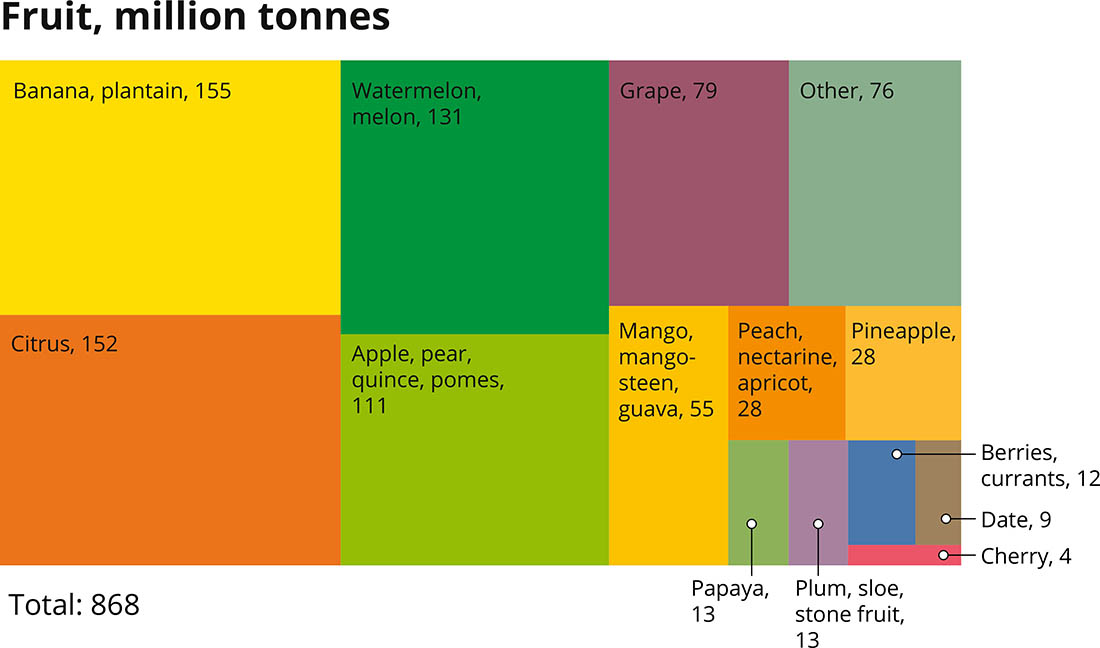
Source: FAOSTAT
The main vegetables were tomato, various alliums (onion, garlic, shallot, leek), brassicas (cabbage, cauliflower, broccoli), and cucumber. But overall, “other” fresh vegetables are more important than any of these individual categories: nearly twice as many “other” vegetables were produced than tomatoes (Figure 3).
Figure 3. World vegetable production by commodity, 2018

Source: FAOSTAT
The world’s main producing region of both fruit and vegetables, by a long way, is East Asia, followed by South Asia (Figures 4 and 5). Other major producing regions are South America, Southeast Asia and Southern Europe (for fruit), and Southeast Asia (for vegetables). Northern and Western Europe produce relatively little, so have to import much of what they consume (see Chapter 4).
Figure 4. World fruit production by region, 2018

Source: FAOSTAT
Figure 5. World vegetable production by region, 2018
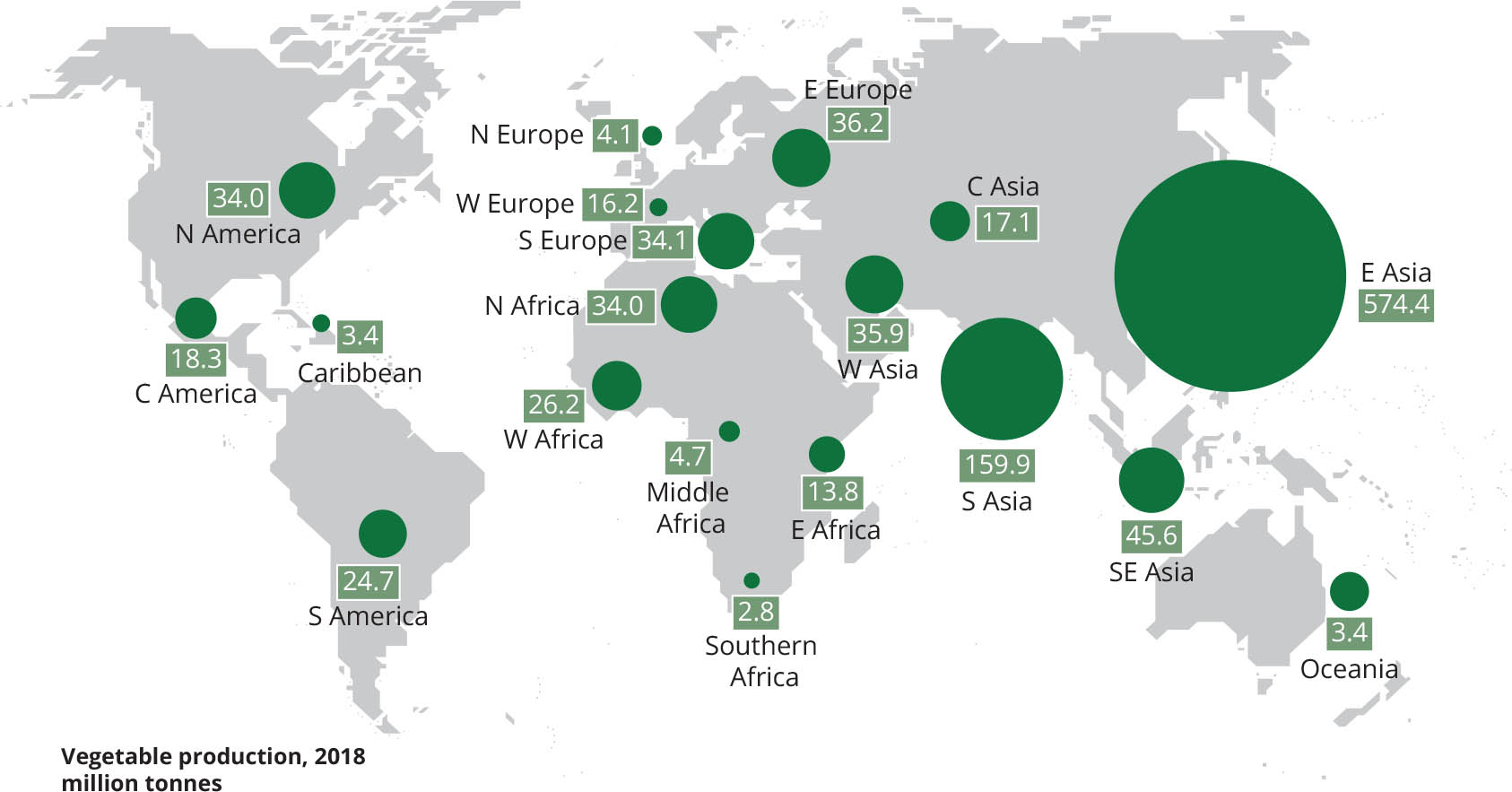
Source: FAOSTAT
Nonetheless, production statistics cover only a few of the many species of fruit and vegetables that are grown and consumed. A large proportion of the output of small-scale producers also does not appear in the official production and trade statistics. Home gardening and production for home consumption are vastly undocumented, so their impact is largely unknown. We need to better understand the diversity and reality of different production systems.
Worldwide production of both fruit and vegetables rose by about half between 2000 and 2018 (Figure 6). The biggest absolute increase was in Asia, especially East Asia (where China is by far the largest producer). In relative terms, the biggest increases were in Central Asia (where production of both fruit and vegetables more than tripled) and Central Africa (nearly triple the amount of fruit and double the volume of vegetables, though from a very low base). Production of vegetables also doubled in East and West Africa.
Figure 6. Change in production of fruit and vegetables, 2000–2018
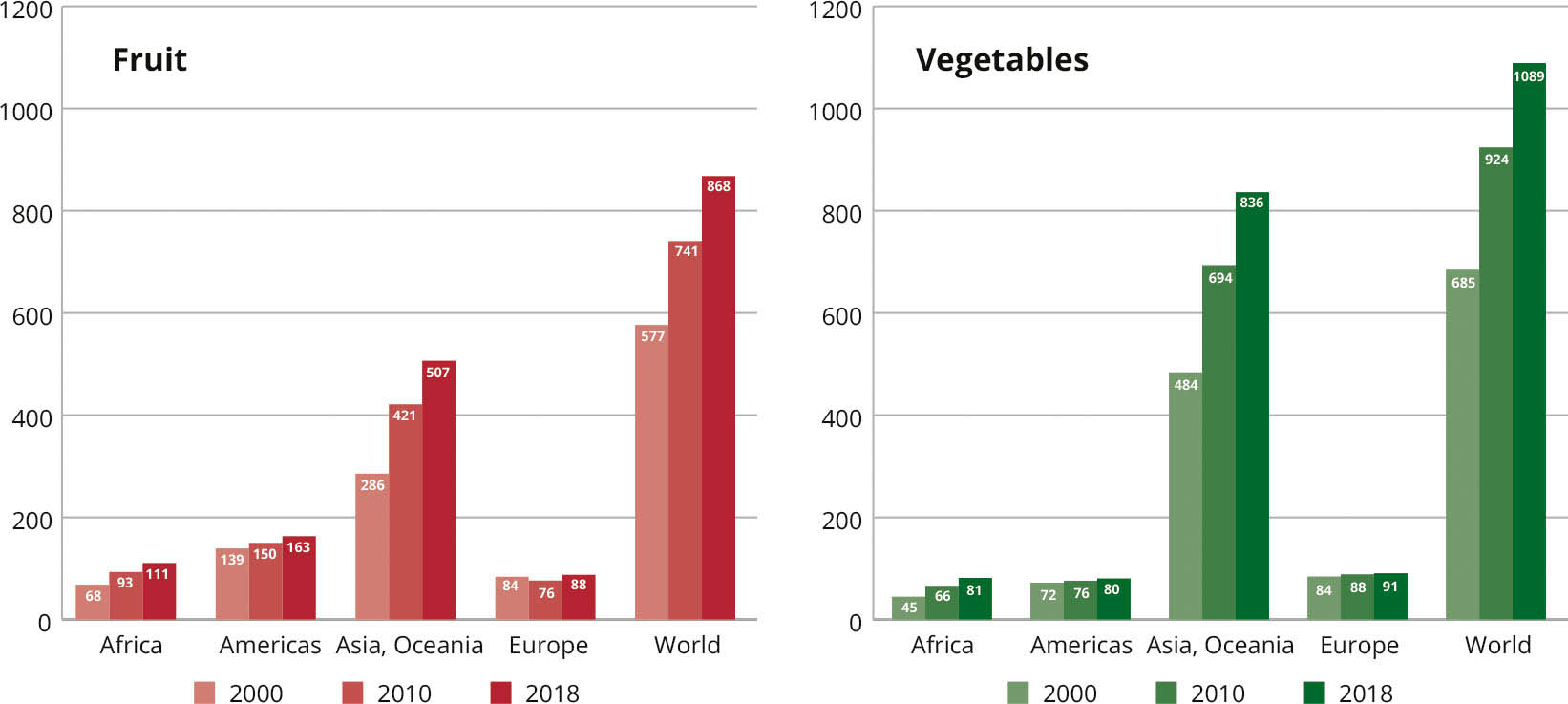
Source: FAOSTAT
Production in some regions has stagnated or even declined: in Northern America and Southern and Western Europe (fruit and vegetables) and in Northern Europe (vegetables only).
The world is producing more fruit and vegetables – but still not enough. In 2000 world production totalled just 306 grams per person per day. By 2017 this had risen to 390 grams (FAO, 2020) – but this includes non-edible portions such as the core and peel, as well as loss and waste, which are often very high. WHO recommends that people should eat at least 400 grams of fruit and vegetables a day (Mason-D’Croz et al., 2019).
Distribution and access problems mean that many people cannot get the types or amounts of food they need (Chapter 4). A sizeable proportion of the harvest is lost or wasted before it reaches consumers’ plates (Chapter 5). Climate change and a lack of water for growing crops will make it difficult to produce enough to meet the WHO’s recommended daily intakes (Mason-D’Croz et al., 2019). And the 400-gram-a-day figure is an average: the actual recommended amounts depend on factors such as age and sex (Chapter 2). Making sure that everyone can get enough fruit and vegetables will require improvements along the entire value chain, from production to processing, marketing, and finally consumption.
The umbrella term “fruit and vegetables” covers an incredible range of species, varieties, cropping systems, agro-climatic conditions, and farm and market types. No single production approach can be used for them all. For production to be sustainable, the practices and technologies must be adjusted to the local context.
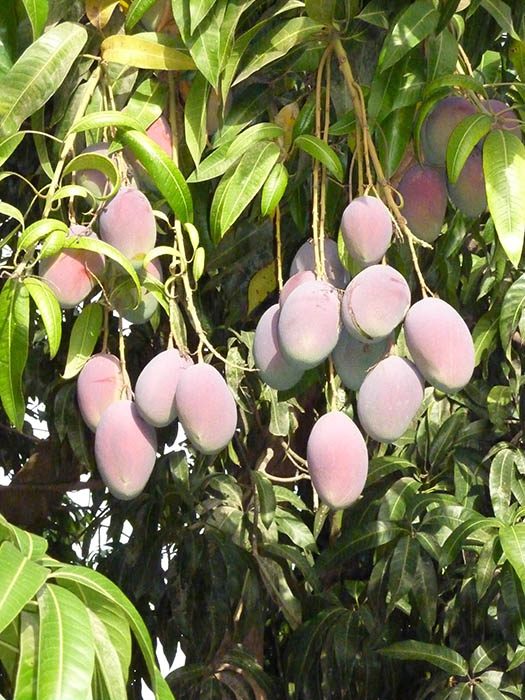
Producers
Small-scale producers
Family farmers, who are often (but not always) small-scale producers, account for 80 percent of the world’s food in value terms (FAO and IFAD, 2019), as well as a large share of fruit and vegetables.
Worldwide, over 50 percent of the fruit and vegetables are grown on farms smaller than 20 hectares (most of which are family farms). In developing countries, such farms grow the vast majority of horticultural produce – over 80 percent in most of Asia, sub-Saharan Africa and China (Figure 7).
- In Cambodia, fruit and vegetables are the second most important commodity group after rice in value terms and provide the main additional source of income for most households in the country (Altendorf, 2018).
- Around 80 percent of avocado production in Mexico is estimated to be carried out by small-scale farmers (Altendorf, 2019).
- Some 200 000 rural families are reported to be directly involved in, and benefiting from, banana production in Guatemala (Altendorf, 2019).
Figure 7. Production of fruit and vegetables by farm size and world region

Adapted from Herrero et al., 2017.
In Europe and North and Central America, medium-sized farms of 20–200 hectares are more important, while it is only in South America and in Australia and New Zealand that farms over 200 ha dominate.
Fruit and vegetables typically are more profitable than staple crops for a given area of land. They also require more intensive management. That opens opportunities for small-scale farmers to take advantage of rising demand and to earn more by producing and marketing fruit and vegetables. Small-scale production also has the potential to protect the environment and ensure social equity (FAO, 2012). Women, in particular, can benefit as they are frequently engaged in fruit and vegetable production and marketing (Fisher et al., 2018).
Small-scale family farms are often more diverse than larger farms, with a mix of staple crops, fruit, vegetables, other crops, and livestock. This mix allows them to spread their risk: if one crop fails, they have others to fall back on. Diversity also means ecological balance, with crop residues used to feed livestock and manure used to fertilize crops. Different crops harbour pollinating insects and beneficials that control pests.
Many countries are currently experiencing a decline in the numbers and diversity of insects, threatening the many fruit and vegetable crops that rely on insect pollination. The small size of many family farms can help preserve biodiversity. At the same time, diversified systems are more knowledge-intensive and require skills to manage them efficiently.
But small scale and a diversity of products makes it difficult for individual farmers to market their produce effectively. Marketing must therefore rely on farmers getting organized into groups or entering contract-farming arrangements with traders (see Chapter 4). As a group, farmers can perform collective actions such buying inputs, hiring services and selling their output. The group members can also swap ideas and experience, and they have a bigger chance of receiving technical advice.
Urban and peri-urban producers
Many of the smallest-scale producers are found in and around towns and cities. They include commercial growers who sell their output to local markets, as well as home-gardeners and community gardeners who grow produce for their own consumption or to share with friends and neighbours. Surplus produce is sometimes sold directly to consumers or to small-scale traders. These producers can increase the availability and access to fruit and vegetables for urban dwellers. The COVID-19 pandemic has highlighted the importance of local production (FAO, 2020).
Bad roads mean that highly perishable fruit and vegetables cannot be transported far. This is less of a problem for cereals or crops like cacao and coffee, which can be dried, bagged, loaded onto trucks and hauled off to distant markets. This is one reason intensive commercial horticulture tends to cluster around urban areas.
While growing fruit and vegetables in and near cities has advantages, it also brings risks – of pollution, contamination, and the loss of land to urban growth. In addition, in some countries urban agriculture does not fall under the responsibility of the ministry of agriculture, so growers cannot benefit from extension services or government-supported inputs (Aubry and Manouchehri, 2019; Taguchi and Santini, 2019).
Large-scale commercial producers
Larger-scale commercial producers of fruit and vegetables tend to focus on a relatively small range of major crops, such as tomatoes, bananas and pineapples. Many of these are destined for the export market or for industrial processing. Depending on the structure of the market, there may (or may not) be opportunities for small-scale farmers to take advantage of larger farms and processing facilities nearby through arrangements such as contract farming.
Sophisticated technologies such as irrigation systems, artificial lighting, hydroponics and digital information systems require capital investment and special skills; only larger commercial operations can afford these. In countries such as Kenya and Ethiopia, growers raise green beans and other vegetables in greenhouses and export them by airfreight to dealers in Europe. However, even smaller-scale producers can adopt technologies such as greenhouses and drip irrigation.
Inputs
Production and marketing technologies
Technologies have been developed that make the production, processing and marketing of fruit and vegetables more efficient. These include the following.
- Production: tissue culture and grafting for seedling supply, high yielding and disease-tolerant cultivars, grafting, precision agriculture, drones, extension advice systems, irrigation, greenhouses, insect-breeding for pollination and pest control, pest identification and management, conservation-farming techniques.
- Harvest and postharvest: harvesting, sorting and packing equipment, improved packaging and storage techniques (see Chapter 5).
- Marketing: market information systems, digital communications, traceability systems, remote payments (see Chapter 4).
These technologies not only increase productivity, yields and quality; they also reduce losses, cut the amount of the labour required, and place greater emphasis on management skills. They are also more likely to attract young, better-educated people to the horticultural professions and create new business opportunities both on- and off-farm. However, they involve capital outlays that may be beyond the reach of poor small-scale producers.
Quality seeds and planting materials
Annual crops such as cabbages and onions rely on quality seeds or other planting materials to produce high yields. Perennials such as citrus, apples and grapes depend on clonal seedlings or grafted cuttings. These planting materials must be genetically pure, have a high germination rate, and be disease-free. Varieties must be adapted to the local environment and to market preferences in terms of colour, shape and taste. And they must be available for the market in different forms: fresh, dried, canned, juiced or fermented (FAO, 2001).
In many countries, quality planting materials are not easily available. Suitable improved cultivars either do not exist or are in short supply. Tissue-culture programmes to produce planting materials are few. Farmers fall back on seeds they have produced themselves, or exchange planting materials with their neighbours. This has advantages (it conserves local varieties) and disadvantages (farmers cannot get the varieties they need to boost their harvest). These drawbacks result from inappropriate policies and the lack of a conducive environment for a thriving seed sector (Tata et al., 2016).
Water
Many fruit and vegetables differ in their water requirements: they need the right amount of water at the right times. Too much water causes root rot. Too little, and they wilt. Gardeners say that tomatoes are particularly finnicky: they need “dry heads and wet feet”. Irrigation is often needed to supplement rainfall (and of course is indispensable in greenhouses). But irrigation water in some areas and seasons is scarce, leading to efforts to get “more crop per drop” (FAO, 2003).
Many small-scale farmers use watering cans to water their vegetables: this is practical in small greenhouses and in gardens close to the house. In larger areas, various irrigation systems are used, using overhead systems, furrows or drip-irrigation (pipes with tiny holes that allow water to dribble out, Wainwright et al., 2013). Irrigation can use “grey water” from washing (after simple filtration), but using “black water” that contains faecal matter is a problem as it may contaminate the soil and crops. Sophisticated systems use biological filtration to recycle water and reduce contamination.

Fertilizers
In places where fruit and vegetables have a low priority, little investment has been made by either governments or the private sector in ensuring that farmers can obtain and learn about suitable fertilizer formulation, proper placement and recommended dosages. As a result, many farmers cannot get the expected yields. The types and amounts of fertilizer applied should be determined based on soil analysis; excess applications should be avoided.
The supply of synthetic fertilizers could be improved through bulk procurements by farmer groups, and by “smart” subsidies and credit schemes to help farmers buy the inputs they need.
Compost is important in fruit and vegetable production, and applying it is more practical than for cereals because the areas involved tend to be smaller. Many small-scale farmers know this already: they compost their farmyard manure to fertilize their vegetable patch rather than spreading it thinly over their crop fields. Mulch is useful to cover the soil, conserve soil moisture and suppress weeds.
Pest and disease management
Perfect papayas, beautiful bananas, the choicest cherries: many types of fruit and vegetables must appear flawless to be saleable. But many are hypersensitive to pests and diseases. The tiniest blemish can demote them from Grade A to the animal-feed bin.
To avoid this, farmers often apply more chemicals than they need in order to control pests and diseases and fulfil their buyers’ requirements. Indiscriminate and excessive use of chemicals cause health and environmental problems for farmers (Tsimbiri et al., 2015), harm beneficial insects, and contaminate the product, resulting in food-safety concerns.
Integrated pest management is the solution. This is an ecosystem-based strategy that focuses on preventing pests and disease in the long term through a combination of biological control, habitat manipulation, improved cultural practices, and the use of resistant varieties. Farmers use pesticides judiciously and only if careful field checks show they are needed – not as a preventive measure, as is all too common (Flint, 2012).
New technologies such as smartphone apps and accredited laboratories now make it possible to identify pests and diseases quickly and recommend ways of dealing with them (Miller et al., 2009). However, agrochemicals companies may use apps to promote the sale of their products, without alerting farmers to other ways to control pests. It is important to reinforce producers’ knowledge and critical thinking and enable them to obtain accurate information and technologies to solve problems.
A number of biopesticides are available on the market that are less harmful to the environment, but these must also be used judiciously. Participatory approaches such as farmer field schools have been successful in promoting integrated pest management worldwide.
Good agricultural practices
Improved seed and planting materials, adequate watering and integrated pest management are all part of a set of “good agricultural practices” that farmers should use to grow enough fruit and vegetables in a sustainable manner. Other technologies include:
Crop rotations and intercropping. Rotating crops helps maintain soil fertility and control pests and diseases. Single-season vegetables can be rotated with staple cereals and other crops. It is important to follow the correct sequence of crops, as some crop species do not grow well next to or after others (Figure 8). Vegetables can also be grown in alternating rows and bands, or between rows of fruit trees. Fruit trees can be grown around fields or on bunds, where they help stabilize slopes.
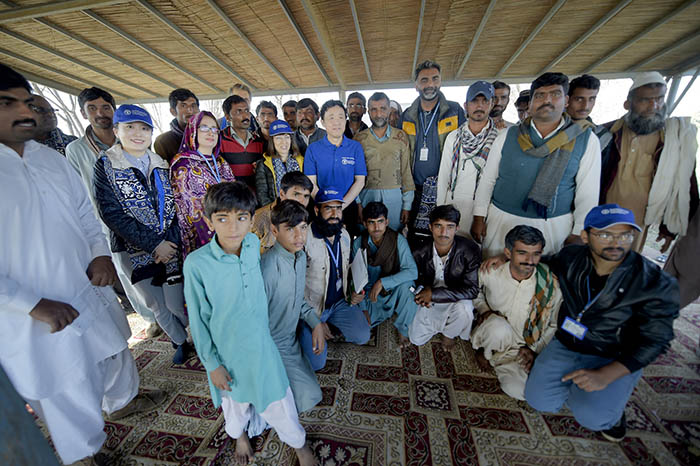
Figure 8. Recommended crop rotations for vegetables in the UK
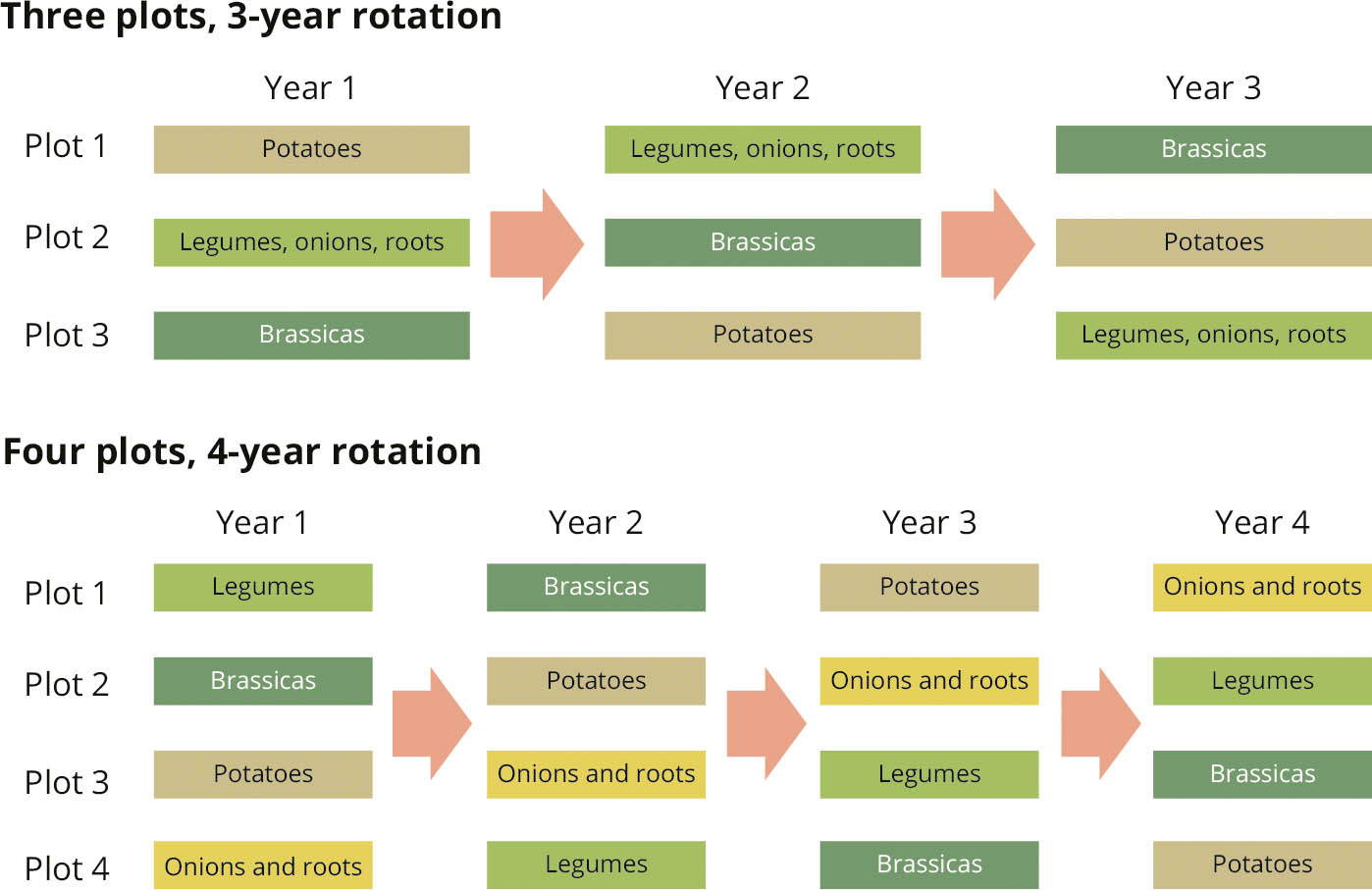
Adapted from RHS (2020)
Integrated production with livestock. Livestock can be grazed under fruit trees, where they help suppress weeds and fertilize the soil, or on vegetable fields after the harvest. Animals can be fed with crop residues such as discarded cabbage leaves or blemished fruit. After proper treatment, manure can be used to fertilize gardens and fields.
Soil amendments. Amendments such as mulch, compost and lime can suppress weeds, control erosion, and boost fertility. Some amendments (mulch, compost) can be made on-farm (the quality of the compost is important, otherwise it may contain weed seeds). Other amendments, such as lime, may need to be brought in from elsewhere.
Reduced tillage. Farmers plough their soil mainly to control weeds. But ploughing has many disadvantages: it destroys the soil structure, reduces soil moisture, kills soil organisms, speeds the breakdown of organic matter, and hastens the release of carbon dioxide into the atmosphere.
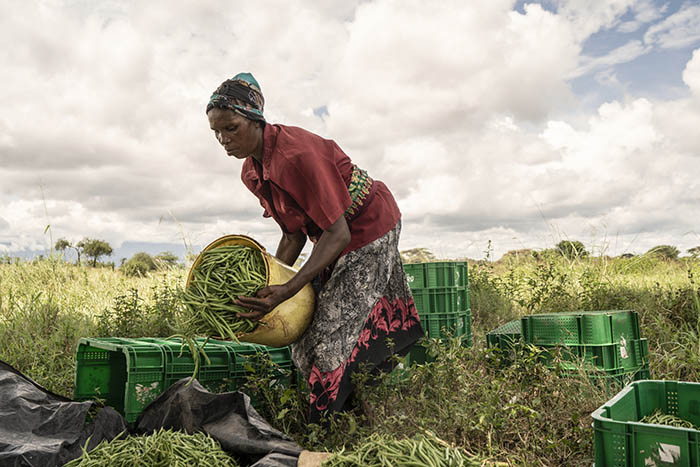
It is better to reduce the amount of tillage or avoid it altogether, for example by sowing seed in individual furrows or using specialized planting equipment. Transplanting seedlings enables them to get ahead of weeds; dense planting and applying mulch also suppress weeds. So can herbicides, though these risk polluting the environment, harming biodiversity and contaminating the crop.
Organic farming. Organic farming avoids using synthetic inputs altogether, using many of the principles described above (Scialabba et al., 2015). It relies on dense planting and mulching to suppress weeds, close crop sequencing to avoid fallow periods, crop associations to control pests, careful water control, and intensive observation and maintenance. It is particularly suited to small-scale fruit and vegetable growing where gardeners can provide the level of labour and management required.
Many fruit and vegetable growers in low- and middle-income countries are de facto organic producers because they have no access to agrochemicals, cannot afford them, or prioritize their staple crops for the little fertilizer they are able to buy. They could benefit from training and advice in crop management and from improved seeds and planting materials.
Environment
Resource use
Nutrient-dense foods such as fruit and vegetables tend to have lower environmental impacts than carbohydrate-rich staples such as cereals (Clark et al., 2019). Per unit of land, water and nutrients, fruit and vegetables are more effective at providing nutritional security than other crops. That can help prevent the expansion of farming into forest areas that are important for biodiversity and carbon sequestration.
Nonetheless, intensive and unsustainable fruit and vegetable production can use excessive amounts of fertilizers and pesticides, which may harm biodiversity and contaminate surface and groundwater.
Climate change
Comparatively little research has been done on the effects of climate change on fruit and vegetable production. Various aspects of climate change may affect fruit and vegetable production: temperature, carbon dioxide concentrations, ozone levels, water availability and salinity. Their effects are likely to vary from place to place. Some are positive (rising CO2 levels are expected to stimulate plant growth); others are negative (reduced water availability harms it) (Scheelbeek et al., 2018). Many fruit and vegetable species are highly sensitive to temperature extremes, such as frost during blossoming and heat during flowering. Some crops stop growing if the temperature is not within the appropriate range; others suffer disorders that make them unmarketable: bean pods get stringy, cauliflowers develop hollow stems, and lettuces “bolt” (grow extended stems) (Peet and Wolfe, 2000).
Neglected crops and wild species
Of an estimated 400 000 plant species in the world, somewhere between 30 000 and 80 000+ are edible by humans (Brummitt et al., 2020; FAO, 2018). Several thousand are grown as agricultural and horticultural crops. Some 7 000 species have been gathered and cultivated since the advent of agriculture. But the world’s food supply depends on just 200 plant species (many of which are fruit and vegetables), and only 12 species provide three-quarters of the food we consume; just nine account for 66 percent of total crop production (FAO, 2019; IDRC, 2010). Most of the remaining minor crops are also fruit and vegetables, as are the vast majority of other edible species.
These species and landraces are often referred to as “neglected and underutilized” because they have been “forgotten” by agricultural research and investments. They include traditional crop species and varieties, as well as wild species that people often also harvest and use as food. They present enormous untapped potential for small-scale farmers and rural communities. They are often more nutritious and more resistant to pests and diseases than are commercial varieties (Schreinemachers et al., 2018). They are well-adapted to the local climate and pests. They are resilient and require few or no inputs, often growing as weeds in and around fields and along roadsides, so are typically accessible for both landowners and the landless.
Many traditional crops and wild species are sold in local markets (Mundy, 2014). They help maintain food and nutrition security and act as a buffer in disaster-prone areas (Rahim et al., 2009). Such species and varieties can be developed to broaden the food basket in face of the threat of climate change (Padulosi et al., 2013). Wild foods contribute to dietary quality, dietary diversity and seasonal evenness (Powell et al., 2015), providing important nutrients and complementing many staple-based diets in any given month of the year.
It is important to develop strategies that can help indigenous food crops to effectively contribute to food security, nutrition, health and economic development (Kahane et al., 2013). This will require the creation of favourable policy environments and increased investments (Jaenicke, 2013), production and dissemination of information (Pichop et al., 2016), and promotion of research, knowledge management and capacity building, e.g., to promote breeding programmes focusing on the development of adapted varieties (COAG, 2018).
Crop biodiversity
Farmers and gardeners around the world maintain a wide range of traditional varieties of fruit and vegetables. But this wealth is under threat from various sources. Commercial pressures induce farmers to adopt high-yielding types instead of lower-yielding but hardier traditional sorts that have limited consumer demand. Seed producers market only commercial varieties – often hybrids that produce useless seed or no seed at all. When older varieties of fruit trees die, they are not replaced. Cross-pollination with imported varieties dilutes the genetic purity of local types. Pests, diseases, drought and heat take their toll on the remaining populations of traditional varieties and may force them into extinction.
In high-income countries, seed companies breed, multiply and market seeds of horticultural crops, and commercial nurseries raise seedlings of vegetables and fruit trees. Universities, research institutes and nongovernment organizations also conserve and distribute seeds of traditional varieties. Such services are rare or non-existent in low- and middle-income countries – except for a few commercial species such as bananas and pineapples. Farmers must rely on their own seed or on local seed exchanges. This conserves biodiversity, but means that farmers do not have access to suitable higher-yielding varieties.
The World Vegetable Center, the international research institute with the mandate for vegetables, maintains a genebank with 61 000 accessions from 155 countries, including about 12 000 accessions of indigenous vegetables (World Vegetable Center, 2020b). But much less work has been done to characterize and conserve the germplasm of most fruit and vegetable species than for the major staple crops. The International Rice Genebank, by contrast, holds more than 132 000 accessions of rice and its wild relatives (IRRI, 2019a).
Policies and institutions
Sustainable intensification of fruit and vegetable production calls for political commitment, investment, institutional support and a demand-driven approach to technology development. There is no “one-size-fits-all” set of recommendations. Still, it is possible to identify the key features of enabling policies and institutions for sustainable intensification of small-scale fruit and vegetable production. The design, implementation and monitoring of policies will require strong collaboration between different ministries and administrations, from public health and education to trade, environment and agriculture.
Research and technology development
Compared to major staples such as rice and wheat, relatively little public effort has gone into developing improved technologies for fruit and vegetables. This is because in the past, governments and international organizations have focused on ensuring food security in terms of calories rather than in terms of nutrients: they have put more effort into filling plates rather than increasing the variety of food on the plate. It is also because of the sheer number of fruit and vegetable species, each of which needs its own breeding and research programme.
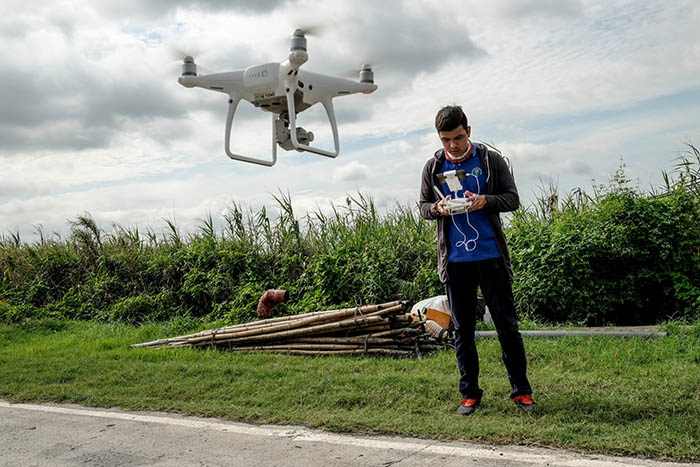
The funding devoted to research on all types of crops is inadequate given the importance of these crops, the challenges facing them, and the proven and potential payoff of research and development. The International Rice Research Institute has a budget of USD 73 million and focuses on a single crop (IRRI, 2019b). That is still far more than the budget of the equivalent institute devoted to vegetables, the World Vegetable Center, which has a budget of around USD 20 million and must deal with a whole basketful of crops (World Vegetable Center, 2020a). There is no international research centre focusing on fruit.

The majority of agricultural research is performed by public institutions such as government research institutes, universities, and international centres (Beintema and Elliot, 2011). Figures on private-sector research are difficult to find but appear to be lower than publicly funded research. Most private research focuses on high-income countries, with very little going to low- and middle-income countries.
Fruit and vegetables account for a small proportion of the total agricultural research effort, and most horticultural research focuses on the major commercial and export crops, such as bananas, rather than on the wide range of crops that are locally important and do not appear in trade data. More research is needed to support sustainable domestic production and the conservation and promotion of neglected and underutilized species, especially in regions where projected supply is particularly inadequate, such as sub-Saharan Africa, parts of Asia and the Pacific (Mason-D’Croz et al., 2019).
Research is needed to breed varieties with disease- and pest-resistance, tolerance to heat, drought, flooding and salinity, and with increased nutrient content. Other priority topics include crop-management techniques, the control of pests and diseases, water-efficient irrigation methods such as drip irrigation and recycling of used water, good soil management and conservation methods to enhance plant health, and the use of appropriate farm machinery to reduce labour needs and improve productivity.
Greenhouses offer many opportunities to lower the environmental impact of growing vegetables, for example by optimizing energy use, reducing the emission of CO2, improving the efficiency of water use, and controlling pests and diseases.
But small-scale producers grow most of the world’s fruit and vegetables, and technologies are needed that suit their conditions and their pockets. Women, who manage a big share of the world’s gardens, must be ensured access to new techniques. The development and deployment of such technologies offer business opportunities for youth employment on- and off-farm. Further along the value chain, technologies are needed to improve postharvest services, storage, transport and processing in order to preserve nutrient content and taste, and to reduce losses.
Extension services
Like agricultural research, extension services are generally focused on major staple and cash crops. Most extension workers are trained in the major crops first and other topics second; when they meet farmers, the big crops take up the biggest part of the time.
Nonetheless, fruit and vegetables pose very different problems for farmers at all stages – inputs, production, harvesting and marketing. Each crop presents its own challenges, suffers from its own pests and diseases, and must be marketed in its own way. Extension personnel need to be able to advise farmers on all these topics.
The internet and smartphones enable producers to learn about various aspects of production and marketing, as well as to discover prices, link with buyers, and make and receive payments. They also make it easier to gather, collate, analyse and report data on areas, production, yields and prices. While commercial famers in high-income countries typically obtain information and fill in forms on a computer, smaller-scale farmers and those in low- and middle-income are more likely to use their smartphones. Both government and private operators are developing services for farmers, typically focusing first on staples and cash crops such as cacao and coffee, but also covering major horticultural crops such as tomatoes.
The advent of smartphones presents new opportunities (it is possible to communicate with farmers without having to travel) but reinforces old problems (how to reach the poorest farmers, especially women). Private operators also face the problem of finding ways to pay for their services: advertisers are scarce in poor areas, and farmers are unwilling or unable to pay for subscriptions (CTA, 2015). Connectivity and internet facilities in rural areas need to be improved before connected devices can be used. This is especially important with the recent upsurge in online marketing activities.
Rural infrastructure
The infrastructure needed for fruit and vegetables also poses challenges. A few species, such as onions, are relatively robust and can be tipped into sacks or loaded onto lorries in bulk. Others, such as tomatoes, mangoes and soft fruit, are extraordinarily delicate and must be handled with great care. They require careful sorting and grading to remove damaged fruit, special packing to protect them on the road, and refrigeration throughout their journey to keep them in tip-top condition. They do not take kindly to being bounced on the back of a truck bumping along a corrugated dirt road.
Investment in roads, electricity (for cold rooms), internet access, warehousing and processing capacity in production zones will help link farmers to markets for fresh produce and to processors that convert them into products with a longer shelf life. This will also help stabilize prices, reduce postharvest losses and lower transaction costs.

